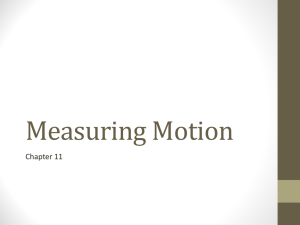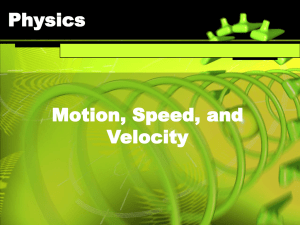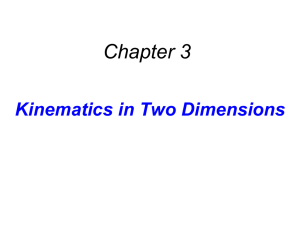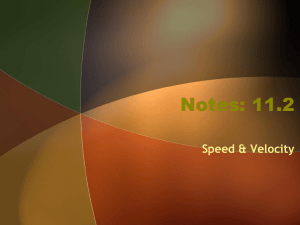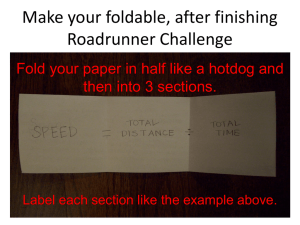motion
advertisement
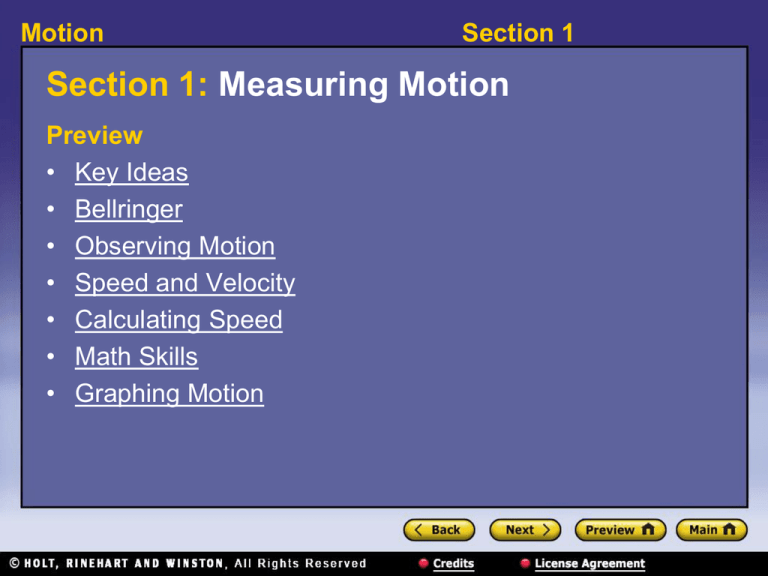
Motion Section 1 Section 1: Measuring Motion Preview • Key Ideas • Bellringer • Observing Motion • Speed and Velocity • Calculating Speed • Math Skills • Graphing Motion Motion Section 1 Key Ideas 〉How is a frame of reference used to describe motion? 〉What is the difference between speed and velocity? 〉What do you need to know to find the speed of an object? 〉How can you study speed by using graphs? Motion Section 1 Bellringer Everybody knows what motion is, but how do you measure it? • One way is to measure distance, or how far something goes during a motion. • Another is to measure time, or how long a motion takes to occur. • A third way is to measure speed, or how fast something is moving. Each of the devices shown below can be used to measure some aspect of motion. Motion Section 1 Bellringer, continued 1. For each of the devices above, indicate whether it measures distance, time, or speed. 2. For each of the devices above, indicate which of the following units are possible for a measurement: meters (m), seconds (s), or meters per second (m/s). Motion Section 1 Observing Motion 〉How is a frame of reference used to describe motion? 〉When an object changes position with respect to a frame of reference, the object is in motion. • motion: an object’s change in position relative to a reference point • frame of reference: a system for specifying the precise location of objects in space and time Motion Visual Concept: Motion Section 1 Motion Section 1 Observing Motion, continued • Distance measures the path taken. • Displacement is the change of an object’s position. – displacement: the change in position of an object – always includes direction • In the diagram: – yellow line = distance – black arrow = displacement Motion Section 1 Speed and Velocity 〉What is the difference between speed and velocity? 〉Speed tells us how fast an object moves, and velocity tells us both the speed and the direction that the object moves. • speed: the distance traveled divided by the time interval during which the motion occurred • velocity: the speed of an object in a particular direction Motion Visual Concept: Speed Section 1 Motion Section 1 Speed and Velocity, continued • Velocity is described relative to a reference point. – Direction is described as positive or negative along the line of motion. – By convention, up and right are usually positive, and left and down are negative. • Combined velocities determine the resultant velocity. Motion Section 1 Visual Concept: Speed and Velocity Motion Visual Concept: Velocity Section 1 Motion Section 1 Calculating Speed 〉What do you need to know to find the speed of an object? 〉To calculate speed, you must measure two quantities: the distance traveled and the time it took to travel that distance. Motion Section 1 Calculating Speed, continued • Average speed is calculated as distance divided by time. distance d speed = , or v time t • SI unit for speed: meters per second (m/s) • constant speed: equal distances in equal amounts of time • instantaneous speed: the speed at a given time Motion Section 1 Math Skills Velocity Metal stakes are sometimes placed in glaciers to help measure a glacier’s movement. For several days in 1936, Alaska’s Black Rapids glacier surged as swiftly as 89 meters per day down the valley. Find the glacier’s velocity in m/s. Remember to include direction. 1. List the given and the unknown values. Given: time, t = 1 day distance, d = 89 m down the valley Unknown: velocity, v = ? (m/s and direction) Motion Section 1 Math Skills, continued 2a. Perform any necessary conversions. To find the velocity in meters per second, the value for time must be in seconds. 60 min 60 s t = 1 day = 24 h 1 h 1 min t = 86 400 s = 8.64 x 104 s Motion Section 1 Math Skills, continued 2b. Write the equation for speed. distance d speed = , or v time t 3. Insert the known values into the equation, and solve. d 89 m v (For velocity, include direction.) 4 t 8.64 10 s v 1.0 103 m/s down the valley Motion Section 1 Graphing Motion 〉How can you study speed by using graphs? 〉You can plot a graph showing distance on the vertical axis and time on the horizontal axis. Motion Section 1 Graphing Motion, continued • Motion can be studied using a distance vs. time graph. – time (x-axis) = independent variable – distance (y-axis) = dependent variable • The slope of a distance vs. time graph equals speed. Motion Graphing Skills Calculating Slope The slope of a straight line equals the vertical change divided by the horizontal change. Determine the slope of the blue line shown in the distance vs. time graph. Section 1 Motion Section 1 Graphing Skills, continued 1. Choose two points that you will use to calculate the slope. Point 1: t = 1 s and d = 6 m Point 2: t = 4 s and d = 12 m 2. Calculate the vertical change and the horizontal change. vertical change = 12 m – 6 m = 6 m horizontal change = 4 s – 1 s = 3 s 3. Divide the vertical change by the horizontal change. slope = 6 m /3 s = 2 m/s

